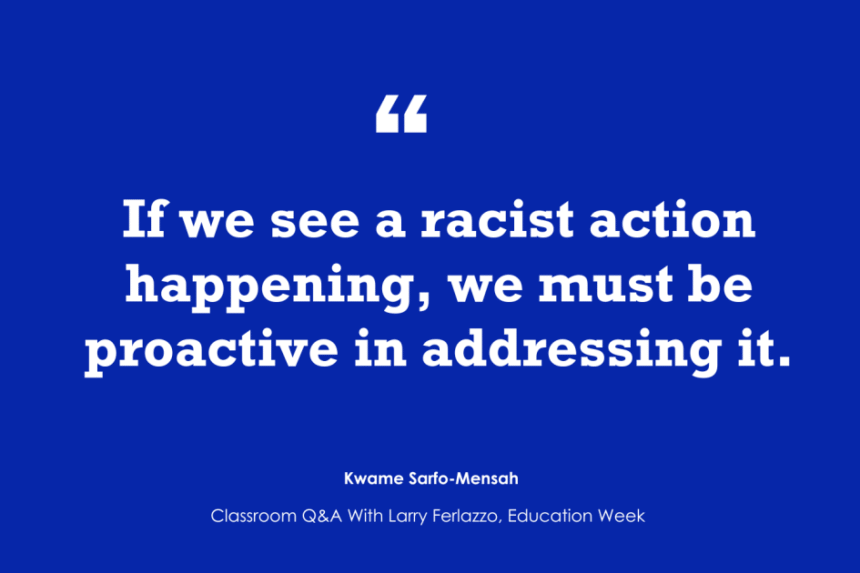Racism exists in our schools, and, in fact, it can be argued that the current political climate may help encourage it.
Today’s post continues a series on what educators can do about it.
‘Intersectionality’
Daman Harris is the manager of the Professional Development Schools program and higher education partnerships in the Anne Arundel County public schools in Maryland:
Using Intersectionality to Raise Awareness of Racism in Schools
During a visit to a winery, my wife and I experienced a subtle yet telling moment of bias. After a pour into our glasses, I noticed that the sommelier consistently poured more wine into my glass than hers. I chuckled and pointed it out to my wife, expecting a light-hearted response. Instead, she replied with a serious tone, “He poured more into your glass every time … ha, ha. … Sexism. I hope you’re including something about that in [the book I was writing at the time].” (So, I did.)
This moment was eye-opening for me. I hadn’t noticed the bias because it didn’t affect me directly, even though it impacted someone I deeply care about. When I suggested we share our observation with the sommelier, my wife calmly replied, “Don’t bother. He probably won’t understand, and the stress would strain our vacation visit. Men often have difficulty recognizing obstacles that are not in their paths.”
Had this experience been related to race, I’m confident I would have recognized the problem immediately. However, since it was related to gender, and I was privileged in that circumstance, I didn’t notice the pattern until it was explicitly pointed out to me. For my wife, this was just another instance in a long line of microaggressions related to gender. For me, it underscored how “racial identity cannot be disentangled from the experience of gender, sexual identity, wealth or class, citizenship, religious identity, ability or disability, body size, or any other core or peripheral aspect of social identity” (Utt & Tochluk, 2020, p. 139).
The winery experience highlights the importance of intersectionality, which is the recognition and support of the multiple identities of each person, with a specific focus on historically marginalized identities. In school settings, “an intersectional approach perceives the diversity of students’ characteristics and seeks to understand their funds of identity—their ways of being, knowing, and experiencing with the goal of improving learning outcomes for all students” (Whitenack, et al., 2019, p. 37).
In simpler terms, it’s hard for people to recognize obstacles that they don’t face, so blending unseen barriers with biases educators experience can help raise awareness and increase their respective abilities to empathize with colleagues, students, and community members whose lived experiences might seem very different. Here are some additional considerations as you plan an intersectional approach to addressing issues of race in your school:
Keep the Spotlight on Bias in Education
- Bias still plays a significant role in educators’ consideration of intersectional support. For example, when analyzing low student achievement, teachers are more likely to consider outside-of-school factors, such as poverty, rather than instructional or disciplinary practices. Culturally responsive pedagogy training alone is not enough to interrupt teachers’ complicity in systems of oppression (Whitenack, et al., 2019), so anti-racism must remain a front-burner issue.
Prepare for “Whataboutism”
- Superficially, intersectionality can seem like a crude form of “Whataboutism.” When asked to confront issues of racialized spaces, resistors might respond, “What about English proficiency?” “What about poverty?” or “What about special education?” as if racial bias doesn’t impact their conversations about any other demographic indicators. To the contrary, intersectionality and anti-racism can be used as mutually supportive frameworks.
Focusing on Voices
- Various forms of biases influence educators’ thoughts about intersectional issues, and there are myriad factors of diversity, so it can be difficult to keep the staff focused on the vision. When dealing with the thoughts and interactions of human beings, there are no monoliths. School leaders might not have the expertise to delve deeply into detailed facets of social science. Therefore, the primary focus should be on whose voices are valued and whose voices are overlooked or excluded (Carbado & Harris, 2019).
Highlighting Connections to Race and Other Factors of Diversity
- Ibram Kendi (2019) elevated intersectionality by combining several factors of diversity into separate strands of anti-racism. For instance, instead of describing discrimination against people who identify as nonbinary as homophobia or sexism, he labels it “gender racism,” which means the fight against it would be “gender anti-racism.”
Naming the Political Backlash Against Equity Work
-
In today’s climate, educators must be prepared to confront a wave of political resistance aimed at silencing conversations about race, gender, and other aspects of identity. Some of our political leaders have repeatedly attacked diversity, equity, and inclusion programs in schools, colleges, and workplaces, casting them as divisive or “un-American.”
Some state legislatures have passed laws that restrict discussions of systemic racism and human identities. The restrictions appear to be designed to create a chilling effect on educators and administrators who aim to build inclusive school environments. Despite this, schools cannot afford to ignore race and identity, especially when these are among the most salient factors shaping students’ lived experiences. Defending intersectional approaches is more than an act of resistance; it’s an act of care.
Conclusion
Intersectionality is a powerful tool for raising awareness of racism and promoting equity in schools, even when (especially when) that work is under attack. By understanding and addressing the complex ways in which different forms of discrimination intersect, educators can create more inclusive and supportive learning environments for all students. As we continue to strive for equity in education, embracing intersectionality can help us move closer to a truly just and inclusive school system.
By adopting an intersectional approach, we can better understand and address the unique challenges faced by our students, ensuring that every child has the opportunity to thrive. Let’s commit to making our schools places where all identities are recognized, valued, and celebrated, even when the political landscape makes it hard to do so.

‘Uncomfortable, But Necessary’
Ruby Ababio-Fernandez, Ed.D., is the co-author of the book Shifting Self and System. She comes to the work with over two decades of experience in schools, including previous roles as an instructional coach, principal, and district leader for the New York City school system:
When I moved to the U.S. from Ghana after age 10, I arrived with messaging from my family and community that nothing was impossible for me. The adults in my life believed in me and expected great things for my future.
However, as I transitioned to America, I quickly realized that the supports I knew did not extend outside my home. In this new culture, I felt out of place and “othered,” a stark contrast to the affirmation I knew in Ghana.
In elementary school, as I worked hard to learn English, my classmates teased me about my skin color and accent, leading me to withdraw and stay quiet in class. Many teachers never stopped to ask why I wasn’t participating or sought to understand me beyond surface-level labels and identity markers. They didn’t see the potential within me or attempt to make learning engaging or relevant.
In my second semester of college, I enrolled in an advanced science class where I was one of the few students of color. I eagerly participated and asked questions, but a professor told me, “Maybe chemistry is not for everybody.” That comment was defining for me and led me to abandon science altogether. Only later did I realize the profound impact teachers had on my life and sense of possibility.
For many students, especially those from underserved communities, experiences like mine are far too common. The disparities in student learning along lines of difference demand a bold and courageous approach to education. This is demanding work but essential for fulfilling the promise of academic excellence for every student. It requires rethinking education through curiosity about how to best serve each child.
From my reflections and practice, there are three key strategies for educators and administrators to advance educational outcomes: a disciplined study of identity and bias, courageous dialogue about belonging, and actions that eliminate predictable systemic barriers to student success.
(1) Study It! Understand Identity and Bias:
Identity shapes how students experience school—and how schools experience students. I only understood the role of social perception in my own life after a disciplined study of how it influenced my socialization, schooling choices, where I lived, and even my career.
Educators should understand the historical and ongoing impact of systemic barriers on marginalized communities, including policies and practices that have influenced access to quality education. Schools that systematically collect diverse stakeholder perspectives are better positioned to address issues of disparities. These insights help us uncover unconscious beliefs that perpetuate gaps in access and opportunity across cultural differences.
(2) Talk About It! Have Courageous Dialogue About Belonging:
I’ve been part of countless conversations about addressing student underperformance and the achievement gap, analyzing data for implications on teaching and learning. These discussions often reveal biases, beliefs, values, and assumptions undergirding outcomes.
Courageously talking means assuming an inquiry stance, asking questions to help surface root cause: Who is and gets to be fully included? Who feels like they belong here? Who benefits from our instructional choices, relationships, interventions, and policies and who is left out? Addressing these kinds of adaptive questions builds awareness and shared responsibility necessary to ensure success for all children.
(3) Act on It! Eliminate Predictable Patterns of Disparities in Educational Practice:
It is not the sole responsibility of certain groups of educators to lead this work. It is crucial for the entire school community to assume collective responsibility for understanding and improving student experiences. This includes ongoing professional development focused on inclusive practices, data-informed decisionmaking, and continuous assessment of educator knowledge on support systems, curriculum, instruction, special education placement, and behavior management framed by inquiry and competence.
Confronting inequities is uncomfortable, but necessary. We’re in a moment of deep polarization, particularly around issues of education, race, and other identity markers, where steps toward progress in one direction often spark outrage and pushback in another.
Understanding how systemic barriers operate can provide insight into our decisions and actions in schools, thereby preventing the perpetuation of low expectations for students. As educators, committing to this work is a pulse check for being purposeful—personally and professionally—and ensures we serve underrepresented students well. Being part of such meaningful work fuels me.

‘Equity Audits’
Kwame Sarfo-Mensah is a 17-year veteran educator and the founder and CEO of Identity Talk Consulting, an independent educational consulting firm that provides professional development and consulting services to K-12 school districts, educators, colleges and universities, and educational nonprofit organizations:
Repairing Racial Harm Through Call Ins – From discriminatory dress codes to the systematic exclusion of BIPOC students from academically gifted programs, racist policies have disenfranchised BIPOC students within our school communities. We can no longer ignore these actions. If we see a racist action happening, we must be proactive in addressing it. This can be done by “calling in” the offender at an appropriate time when you are both ready to engage in a conversation about the racist action that was committed.
For some of you, the act of calling someone in may be uncomfortable, intimidating, and even scary to do. In addition, in some states with anti-DEI laws, there may even be some legal risk. If you work in any of those communities, if you proceed, you want to proceed with extreme caution. Nevertheless,this is the work that needs to be done to eliminate these racist actions. When engaging in the process of repairing harm, there are four main questions that we must consider:
- What was the harm caused?
- Who was directly affected by the harm?
- How has the behavior of the offender (the one causing the harm) affected others?
- What plan can be created and carried out to repair the harm?
Punishment or exclusion isn’t the goal for this process. The ultimate focus should be on community-building through means of education. Given that we live in a society where white-dominant culture is the default, it is inevitable that our mental conditioning within that culture will place us in situations where we subconsciously harm others.
This harm can manifest itself in the most subtle ways. Sometimes, it’s from the language we use. Other times, it stems from our inaction toward injustices within our school communities. It shows up in the curriculum we teach, the books we choose to include or not include in our classroom libraries, the policies we implement, or the manner in which we allow our implicit bias to inform the way we grade, discipline, or interact with different students.
Conducting Equity Audits – Equity audits are necessary to help teachers and school leaders identify and address racial disparities in the classroom and the greater school community. Through equity audits, teachers and school leaders can do the following (given today’s political environment, you will want to double-check that these steps will not put you in legal jeopardy or in danger of running afoul of your district’s policies):
- Analyze academic-achievement data to identify any racial disparities in student performance. This can help teachers understand the impact of systemic inequities on educational outcomes.
- Examine discipline data to identify any racial disparities in disciplinary actions.
- Recommend implicit bias training for teachers to make them aware of any unconscious prejudices that may affect their interactions with students.
- Examine curriculum materials to ensure they are inclusive, representative, and free from biases. Through this examination, teachers can become aware of how the content they teach may contribute to or challenge racial stereotypes.
- Evaluate school policies and practices to identify any that may perpetuate racial disparities.
- Assess whether teaching practices reflect cultural responsiveness and are inclusive of the intersectional identity markers that students hold. This can help teachers recognize the importance of incorporating diverse perspectives into their lessons.
- Elicit feedback from parents, community members, and other stakeholders to gain a more comprehensive perspective of race and racism and how they may impact the school community.
By engaging in these actions within the framework of an equity audit, teachers and school leaders can then create an environment where they can become more aware of the ways in which race and racism impact learning in the classroom. This awareness is a critical first step toward fostering a more equitable and inclusive learning environment for all students.

Thanks to Daman, Ruby, and Kwame for contributing their thoughts!
Today’s post answered this question:
What are the most effective strategies for making colleagues and administrators aware of how race and racism impact what is happening in the classroom and then getting them to take action to do something about it?
In Part One, Mary Rice-Boothe, H. Richard Milner IV, and Angela M. Ward contributed their thoughts.
Consider contributing a question to be answered in a future post. You can send one to me at lferlazzo@epe.org. When you send it in, let me know if I can use your real name if it’s selected or if you’d prefer remaining anonymous and have a pseudonym in mind.
You can also contact me on Twitter at @Larryferlazzo or on Bluesky at @larryferlazzo.bsky.social .
Just a reminder; you can subscribe and receive updates from this blog via email. And if you missed any of the highlights from the first 13 years of this blog, you can see a categorized list here.







